Paul Gilster's Blog, page 127
June 16, 2017
A Fusion Runway to Deep Space?
Beamed propulsion concepts are usually conceived in terms of laser or microwave beams pushing a lightsail. But as we’ve seen over the years, there are other ways of thinking about these things. Clifford Singer went to work back in the 1970s on the concept of pellet streams fired by an accelerator, each pellet a few grams in size. The idea here is to vaporize the pellets when they reach the spacecraft, their energy being redirected as a plasma exhaust.
There are enough interesting variations on the idea that I’ll probably return to it soon. But over the weekend, an email from Jeff Greason reminded me of Jordin Kare’s unusual ‘fusion runway’ idea, to which he attached the moniker the ‘Bussard Buzz Bomb.’ Kare is an astrophysicist and space systems consultant with a background in laser technologies. He’s been involved in studies of laser launch methods, in which beamed energy is focused on an onboard heat exchanger that converts liquid propellant into a gas to produce thrust. Currently he serves as chief scientist for LaserMotive, a laser power transmission firm in Kent, WA.

Image: Astrophysicist and space systems consultant Jordin Kare.
In the interstellar community, Kare is best known for SailBeam, where pellet propulsion is supplanted by tiny micro-sails that are pushed at huge velocities to the spacecraft, to be vaporized there much in the manner of Singer’s pellets. His sails turn out to require a smaller optical system than would be needed to push a large sail, and they can be driven to high accelerations while still close to the beam, reducing pointing and collimation challenges.
But I haven’t said much in these pages about Kare’s fusion runway, which he presented at a Workshop on Advanced Space Propulsion at the Jet Propulsion Laboratory back in the late 1990s. In 2003, when I interviewed him for my Centauri Dreams book, Kare gave me a breakdown of the concept. The idea harkens back to pellets, in this case fusion fuel pellets made up of deuterium and tritium that are slammed together to achieve ignition.
The pellets are laid down in an outbound track for the spacecraft that will eventually use them, deployed in advance by small spacecraft seeding the runway along the route of flight. Kare thinks in terms of a runway about half a light-day in length. The accelerating spacecraft would gobble up the fusion pellets one at a time, taking about ten days to exit the Solar System, moving along a runway track that stretched from near Earth to beyond the orbit of Pluto.
What kind of a craft would this be? Think in terms of a vehicle in the shape of a doughnut, or perhaps in more elongated form as a cylinder. The spacecraft would have its own supply of fusion fuel pellets. As the craft accelerates, it drops a pellet into the central ‘hole’ when one of the pellets of the fusion runway is about to be encountered. Nearing the end of the fusion runway, the spacecraft is being driven by fusion explosions at the rate of thirty per second.
The fusion runway relies on impact fusion, with the departing spacecraft first needing to reach speeds high enough (about 200 kilometers per second, by Kare’s reckoning) to ignite the reaction. Once ignition is achieved, the craft continues to accelerate along the runway track. The runway length would have to be adjusted depending on the mission, with robotic probes obviously capable of coping with far higher accelerations than humans. Add a human crew at 1 g of acceleration and a fusion runway might need to stretch out to a tenth of a light year.
String enough fuel pellets along the runway and the spacecraft gets up to ten percent of c. Although Kare built his workshop presentation around a one-ton interstellar probe, he sees the concept as scalable, telling me in that interview: “The fusion runway doesn’t care if you’re working with a ten or a hundred ton probe. You just need more pellets. You don’t need to build larger lasers. So it probably scales up better than most other schemes.”
Several other advantages emerge in the fusion runway concept. So-called ‘impact fusion’ doesn’t require the exquisitely symmetrical fuel pellets demanded by inertial confinement methods, nor does it demand that each pellet be fed energy simultaneously from every direction. Remember that Kare is assuming a spacecraft that is already moving — through some other energy source — at 200 kilometers per second to achieve ignition. From that point on, velocity depends upon the number of fuel pellets available in the runway ahead.
When I think about possible show-stoppers here, I wonder about accuracy. After all, each runway pellet has to hit the ship-borne pellet precisely, though Kare believes that this could be managed by laser pulses guiding the pellets internally. Perhaps the ship can be designed so as to channel runway pellets to the exact point of collision. Also challenging is the magnetic nozzle that will be necessary to contain the fusion explosions and direct their energy.
As far as getting up to speed, Geoff Landis told me some years back that a close pass by the surface of the Sun could be used to reach somewhere in the range of 500-600 kilometers per second. That could give you the velocity needed for ignition. Line the fuel pellets up so as to begin hitting them outbound and the method could work. In our recent email exchange, Landis does question Kare’s 200 kilometers per second as the sufficient velocity to ignite impact fusion — some figures in the literature point to 3500 km/s for a deuterium/tritium mixture.

Image: Not exactly an interstellar prototype, but the German V1 gives its name to an advanced propulsion concept because of how it would sound (if you could hear it). Credit: Bundesarchiv, Bild 146-1975-117-26 / Lysiak / CC-BY-SA 3.0.
The ‘buzz bomb’ reference? That one is easy. The German V-1 was a pulse-jet rocket that gave off a characteristic staccato buzzing sound much like what a fusion runway spacecraft would sound like if you could hear it at all. The nod to Robert Bussard stems from the latter’s work on interstellar ramjet concepts, craft that pull in interstellar hydrogen to serve as fuel. Thus we have, as so often in interstellar studies, a hybrid design putting two distinct propulsion concepts together in ways that attempt to enhance the performance of each.






June 15, 2017
Do All Stars Form as Binaries?
Interesting news this morning that begins with the Very Large Array in New Mexico, which a team of astronomers has been using to look at star formation. Their target: The Perseus molecular cloud, a stellar nursery about 600 light years from Earth. Clouds like this are sufficiently large (this one is about 50 light years in length) and dense to permit molecules to form, with molecular hydrogen (H2) being the most common, along with carbon monoxide (CO).
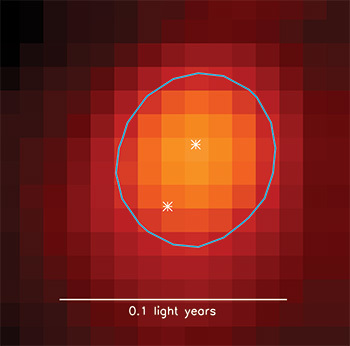
Although we can’t see into them in visible light (they appear as holes in the starry background because dust and gas obscure the stars forming inside, as well as background stars), such molecular clouds are ideally suited for study with radio telescopes. The VLA survey, called VANDAM (VLA Nascent Disk and Multiplicity) surveyed all the young stars in the Perseus cloud, including both single and multiple stars at separations down to < 20 AU. And now a duo of astronomers has supplemented the VLA data with observations from the James Clerk Maxwell Telescope in Hawaii, the latter helping to reveal the clumps of higher density called ‘dense cores’ — think of them as egg-shaped ‘cocoons’ — within which young stars form.
Image: Radio image of a very young binary star system, less than about 1 million years old, that formed within a dense core (oval outline) in the Perseus molecular cloud. According to the new paper, all stars likely form as binaries within dense cores. Credit: SCUBA-2 survey image by Sarah Sadavoy, CfA.
Sarah Sadavoy (Max-Planck-Institut für Astronomie) and Steven Stahler (UC-Berkeley) found 55 young stars in 24 multiple star systems (all but five of these are binary) and 45 single star systems in the Perseus cloud. All the widely separated binaries (> 500 AU) were made up of Class 0 stars (less than 500,000 years old), and were aligned with the long axis of the dense core. The older Class I binary stars (between 500,000 and 1 million years old) were closer together (separations ~ 200 AU) and showed no such alignment.
These alignments may not be random. For the authors have produced a mathematical model that explains the observations, and it’s a model with a twist. What they deduce is that stars like the Sun — all of them — are born with a companion. Says Stahler:
“We ran a series of statistical models to see if we could account for the relative populations of young single stars and binaries of all separations in the Perseus molecular cloud, and the only model that could reproduce the data was one in which all stars form initially as wide binaries. These systems then either shrink or break apart within a million years.”
A wide binary as considered here is one with a separation of more than 500 AU, which would mean that the original binary companion to our Sun, assuming it once existed, would have been about 17 times further out than Neptune is today. Nemesis? Only in that this would have been a companion to our star, though not one that, like the conjectured Nemesis once considered as a hypothesis for driving asteroid collisions with the Earth, stayed in our neighborhood.
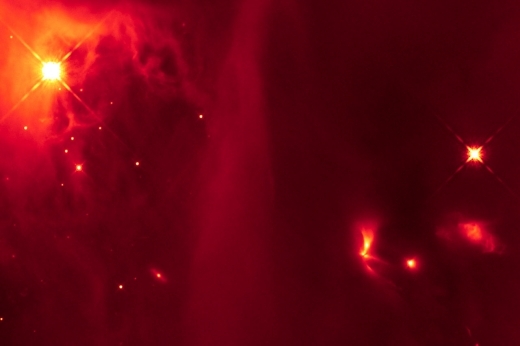
Image: This infrared image from the Hubble Space Telescope contains a bright, fan-shaped object (lower right quadrant) thought to be a binary star that emits light pulses as the two stars interact. The primitive binary system is located in the IC 348 region of the Perseus molecular cloud and was included in the study by the Berkeley/Harvard team. Credit: NASA, ESA and J. Muzerolle, STScI.
In fact, the outcome based on Sadavoy and Stahler’s models is that the Sun’s companion escaped long ago. This would not be an uncommon result, for the early period of star formation would be turbulent. The wide binaries from the early period of star formation either break into separate stars or else shrink into tighter orbits to form tight binaries. Stahler again:
“As the egg contracts, the densest part of the egg will be toward the middle, and that forms two concentrations of density along the middle axis. These centers of higher density at some point collapse in on themselves because of their self-gravity to form Class 0 stars. Within our picture, single low-mass, sunlike stars are not primordial. They are the result of the breakup of binaries.”
An interesting result, and keep this in mind (from the paper): “If our model continues to provide a good fit to other star-forming regions, then the mass fraction of dense cores that becomes stars is double what is currently believed.”
In trying to learn how binary and multiple star systems form, we’ve begun to produce computer simulations examining the behavior of collapsing masses of gas, as well as simulating how young multiple stars behave as they emerge from their gas clouds. What this work addresses is the fact that among the population of young stars, binaries exist in higher proportion. The authors point to the need for higher resolution studies in other star-forming regions to continue the systematic analysis of the role of binaries in early stellar evolution.
The paper is Sadavoy and Stahler, “Embedded Binaries and Their Dense Cores,” accepted at Monthly Notices of the Royal Astronomical Society (preprint). This UC-Berkeley news release is helpful.






June 14, 2017
Focus on Interstellar Prebiotic Chemistry
400 light years away in a star-forming region called Rho Ophiuchi there is an interesting stellar system in the making. Catalogued as IRAS 16293-2422, what we have here is a triple protostar system — a binary separated by 47 AU and a third star at 750 AU. All three have masses similar to the Sun, and while the system is young, it has already achieved a certain fame in that researchers working with data from the Atacama Large Millimeter Array have been able to identify a simple form of sugar called glycolaldehyde in surrounding gas.
Learning that building blocks of life can form in other systems is useful, but here we have sugar in the region where a protoplanetary disk can form, an indication that such materials are widely available in the places where planets begin to coalesce around their host star.
Then just this month we’ve learned that further ALMA work has yielded the prebiotic organic molecule methyl isocyanate (CH3NCO) in the same system. Niels Ligterink (Leiden Observatory) and Audrey Coutens (University College, London), who led one of two teams on this work, issued this statement pointing to the significance of the find:
“This star system seems to keep on giving! Following the discovery of sugars, we’ve now found methyl isocyanate. This family of organic molecules is involved in the synthesis of peptides and amino acids, which, in the form of proteins, are the biological basis for life as we know it.”
The term ‘complex organic molecules’ in this context refers to molecules consisting of six or more atoms, of which at least one is a carbon atom — such organic molecules are widely observed in regions of star formation. Prebiotics are a subset, a category of complex molecules with interesting implications for life. From the Ligterink paper, one of two scheduled to appear in Monthly Notices of the Royal Astronomical Society:
A special category of complex molecules is that of the prebiotics, molecules that can be linked via their chemical structures or reactivity to life bearing molecules, such as amino-acids and sugars. Methyl isocyanate, CH3NCO, also known as isocyanomethane, is a molecule that falls in this category, because of its structural similarity with a peptide bond… This type of bond connects amino-acids to form proteins and as such is interesting because it connects to chemistry relevant to the formation of the building blocks of life.

Image: ALMA detects methyl isocyanate around young Sun-like stars (artist’s impression). Credit: ESO.
Ligterink and Coutens were joined by another team led by Rafael Martín-Doménech (Centro de Astrobiología, Madrid) and Víctor M. Rivilla (INAF-Osservatorio Astrofisico di Arcetri, Florence). Working at several different wavelengths, the researchers found methyl isocyanate in the inner regions of gas and dust surrounding the young triple system. Their computer modeling, supplemented by laboratory experiments, included chemical models of the organic molecule in the gas-grain environment around the stars, a process explained by chemistry on the surface of dust grains in space and subsequent chemistry in the gas phase.
Moreover, the work demonstrated through cryogenic high-vacuum experiments that methyl isocyanate could form at temperatures as low as 15 Kelvin. Both teams applied spectrographic analysis of the light from the triple star system to trace the abundance of methyl isocyanate in comparison to molecular hydrogen, finding it comparable to previous detections around protostars within the Orion KL and Sagittarius B2 North star-forming regions.

Image: The Rho Ophiuchi star formation region in the constellation of Ophiuchus. Credit: ESO.
Thus we continue to home in on the possibility that part of life’s story begins in space, with basic prebiotic chemistry occurring there and transferring prebiotic molecules to star systems in formation and, eventually, the planets that emerge. As a case in point, we find complex organic molecules of the kind commonly detected in interstellar space in comets in our own system (Rosetta found evidence for such on the surface of comet 67P/Churyumov-Gerasimenko). Methyl isocyanate has itself been detected before (in the molecular cloud Sagittarius B2), but never, until now, in protostars of solar mass.
The papers are Doménech et al., “First Detection of Methyl Isocyanate (CH3NCO) in a solar-type Protostar,” accepted at Monthly Notices of the Royal Astronomical Society (preprint) and Ligterink et al., “The ALMA-PILS survey: Detection of CH3NCO toward the low-mass protostar IRAS 16293-2422 and laboratory constraints on its formation,” also accepted at MNRAS (preprint).






June 13, 2017
New Looks at Brown Dwarfs
Small stars are fascinating because of their sheer ubiquity. Some estimates for the fraction of red dwarfs in the galaxy go as high as 80 percent, meaning the planets around such stars are going to be the most common venues for possible life. For a time, I thought brown dwarfs would be shown to be even more numerous, but the WISE [Wide-field Infrared Survey Explorer] data have indicated otherwise (see Brown Dwarfs Sparser than Expected).
Hopes for a brown dwarf closer than the Alpha Centauri stars (and thus a convenient intermediary destination for future probes) have dwindled down to nothing, but we do have interesting systems like Luhman 16 AB, the third closest system to the Sun, captured in the image below via a ‘stack’ of twelve images courtesy of the Hubble instrument. The work is from Luigi Bedin (INAF-Osservatorio Astronomico di Padova, Italy) and team, helping us with orbital parameters of the pair and demonstrating that there is no third companion.
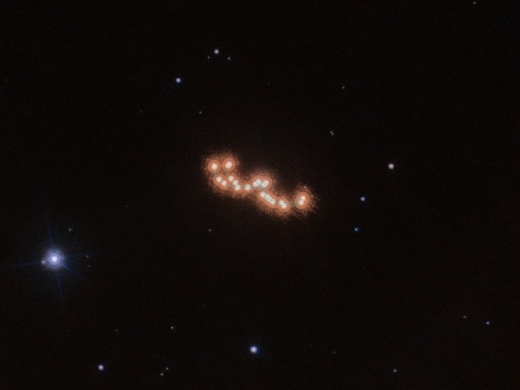
Image: Luhman 16 AB as seen by Hubble in this stack of images. Credit: ESA/Hubble & NASA, L. Bedin et al.
We’ll keep an eye on this interesting system given its proximity. Discovered in WISE data in 2013, the brown dwarfs are separated by about 3 AU in a binary that is 6.5 light years away. Both are of about 30 Jupiter masses. Bedin and colleagues can find no exoplanets of Neptune mass or greater with a period of between one and two years. Future Hubble observations have already been approved for August of next year. From the paper:
We plan to focus on the trailed HST images already collected and those planned for August 2018, to further improve the astrometric precision and search exoplanets down to few Earth masses. Follow-up observations with the VLT/CRIRES+ instrument will provide accurate radial velocity data, an important complement to our 2-D astrometric data, as it will provide the missed component necessary for the complete tri-dimensional picture of the kinematic in the system. In addition, the Gaia DR2 dataset will provide absolute motions, positions, and distances of several stars in the field.
These observations may be able to rule out (or detect) the presence of smaller planets. If they’re there, we can expect further follow-up work with the James Webb Space Telescope as well as the Extremely Large Telescope and other assets. This system is tantalizingly close.
A Brown Dwarf Eclipsing Binary
Kepler is also giving us new information about brown dwarfs, in this case finding one orbiting a white dwarf with an orbital period of a scant 71.2 minutes. The white dwarf is WD1202-024, identified by the Sloan Digital Sky Survey and originally thought to be an isolated star. We learn instead, via data from campaign 10 of the K2 mission (the spacecraft’s extended mission following its reaction wheel problems) that we’re seeing a dramatic lightcurve from a binary. The Kepler data were followed up by five different ground-based telescopes whose combined work revealed that the white dwarf has a mass about 40 percent that of the Sun, while the brown dwarf is equivalent to about 67 Jupiter masses.
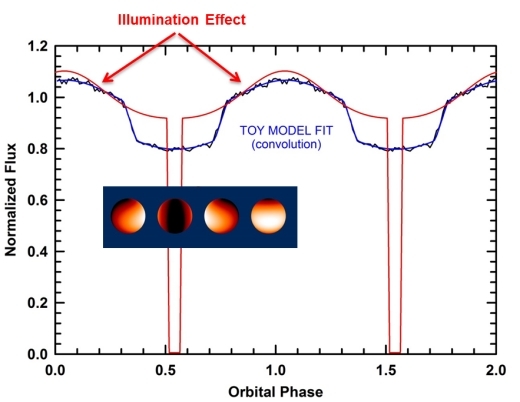
Image: K2 lightcurve (black jagged curve) folded about a period of 71.23 minutes. The red curve represents a simple geometrical model with a 5-minute long total eclipse and a 9% contribution to emulate an illumination effect on the companion star. The blue curve is the fit to the model based on the length of the K2 observations. Credit: Rappaport et al.
The work on WD1202-024 was announced by Lorne Nelson (Bishop’s University, Quebec) at the semi-annual meeting of the American Astronomical Society in Austin (TX), and you can click here for a portion of the press conference at the meeting that included discussion of the system. Saul Rappaport (MIT) and Andrew Vanderburg (Harvard Smithsonian Center for Astrophysics) found the unusual lightcurve among 28,000 K2 targets.
What we are seeing appears to be a white dwarf being eclipsed by a much cooler brown dwarf in a system that is viewed nearly edge-on from our perspective. The team’s computer models showed that the infant binary, having formed about three billion years ago, would have consisted of a 1.25 solar mass star and a brown dwarf in a 150 day orbit. The star expanded over time to become a red giant, engulfing the brown dwarf about 50 million years ago. Nelson explains the process, one which the brown dwarf survived (thus far) relatively intact:
“It is similar to an egg-beater effect. The brown dwarf spirals in towards the center of the red giant and causes most of the mass of the red giant to be lifted off of the core and to be expelled. The result is a brown dwarf in an extraordinarily tight, short-period orbit with the hot helium core of the giant. That core then cools and becomes the white dwarf that we observe today.”
What should emerge out of all this, in about 250 million years or even less, is that the separation of the white and brown dwarf will dwindle until the brown dwarf will begin to be consumed by the star, making the binary into a cataclysmic variable (CV) feeding off accretion from the disk of matter surrounding the white dwarf. At the AAS meeting, Nelson referred to this system as the shortest period pre-cataclysmic variable ever discovered.
The paper is Rappaport et al., “”WD 1202-024: The Shortest-Period Pre-Cataclysmic Variable,” submitted to Monthly Notices of the Royal Astronomical Society (preprint). The Bedin paper is “Hubble Space Telescope astrometry of the closest brown dwarf binary system — I. Overview and improved orbit,” accepted at Monthly Notices of the Royal Astronomical Society (preprint).






June 12, 2017
Frank Malina: Texas Rocket Grandmaster
It’s wonderful to have my friend Al Jackson back at the top of the site with a look at the career and times of JPL’s Frank Malina. Al’s service in the Apollo program came as astronaut trainer on the Lunar Module Simulator; he then spent 40 more years at Johnson Space Center, mostly for Lockheed working the Shuttle and ISS programs. His doctorate was in 1975 from the University of Texas at Austin. The author of numerous scientific papers on interstellar concepts, Al is a fixture at deep space conferences and a continuing source of inspiration on matters scientific as well as science fictional. Today Al gives us an overview of a man who played a key role in the sounding rocket era following World War II, as the infant Jet Propulsion Laboratory began its rich history of exploration and technical development.
by Al Jackson
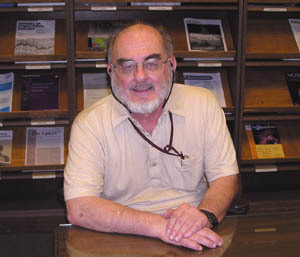
I travel from Houston to Austin by Highway 290 fairly often, and sometimes I stop at Brenham, Texas for lunch. I skip the fast food joints on 290 and go downtown. It is a beautiful small town with a charming old downtown (founded in 1844). Only recently have I become aware that a native Texan from Brenham fulfilled a dream started by Robert Goddard, in fact doing in 10 months what Goddard had for twenty years tried to accomplish. Even more than that, he was co-founder of the Jet Propulsion Laboratory, JPL, and co-founder of Aerojet General. By 1945 he had eclipsed Goddard as the most important American rocket scientist. He was a consummate researcher in the theoretical engineering of rocketry and a master manager of several rocket and rocket vehicle projects for the U.S. Army. So who was the Texas pioneer ‘Wernher von Braun’? Dr. Frank J Malina from Brenham, Texas.
Malina was the originator and leader of a project whose anniversary is today, June 12. It is the 70th anniversary of the last launch of a Wac-Corporal sounding rocket at White Sands. We tend to forget that Robert Goddard had a solid scientific use for his development of rockets — to explore the Earth’s upper atmosphere. We all love Goddard for his inventiveness in rocket hardware and his stubborn individualism, and given time he may have realized his sounding rocket dream. However, while he struggled in the New Mexico desert in 1936, Frank Malina, still a graduate student at Caltech, had put on the wall of his office a chart of how a successful sounding rocket project might be accomplished. Unlike Goddard, he recognized the need for a team and a choice of team captains.
Malina’s dream was interrupted by World War II. Along with his mentor Theodore von Kármán (the great 20th century aerodynamicist), he directed the development of the Jet Assisted Take Off (JATO) rockets for use by the Army Air Force. This work for the U.S. Army led to the formation of JPL, and Malina became its first director. There is a straight line heritage from the solid rocket JATO motors to the intercontinental missiles in the American defense arsenal and even up to the Space Shuttle booster motors. His involvement in this project alone is enough to have made him a famous rocketeer.

Image: Dr. Theodore von Kármán (black coat) sketches out a plan on the wing of an airplane as his JATO engineering team looks on. From left to right: Dr. Clark B. Millikan, Dr. Martin Summerfield, Dr. Theodore von Kármán, Dr. Frank J. Malina and pilot, Capt. Homer Boushey. Captain Boushey would become the first American to pilot an airplane that used JATO (Jet Assisted Take-Off) solid propellant rockets. Credit: NASA/JPL.
In 1944 Dr. Malina was sent to England and France to inspect salvaged V2s and V1 launch sites. Returning by plane over the Atlantic, he decided to ask the Army ordnance department to fund his cherished goal of building and launching a vehicle to sound the upper atmosphere in regions that could not be reached by balloons. This was December of 1944. From designs by H.S. Tsien and Malina, he and Homer Stewart submitted and got approval on a proposal to launch a sounding rocket with a 25 lb payload to 100,000 ft.
There had already been a program started at the newly founded JPL to build military rockets. Malina organized a team to use components developed from this program. It is amazing that the von Kármán-Malina program at JPL during WWII accomplished, on a smaller scale, almost the same technical objectives as von Braun’s huge V2 project. A viable liquid rocket motor using nitric acid and aniline with 1500 lbs of thrust was developed, as was the Private-series of missiles. The main difference being the V2’s much larger rocket motor and especially the guidance system, which was still being researched at JPL by the end of the war.
Once the project was approved, Malina and his JPL crew turned over several ideas for the sounding rocket. It turned out that the solid rocket motors would be too heavy for the flight. They needed a long burn light weight rocket. So a liquid motor powered vehicle boosted quickly to a high speed was designed. They needed the initial boost in order to gain a sufficient amount of stability from the vehicle fins since they had yet to developed an active onboard guidance system. The booster system used some of the solid rocket technology in the JATO units that JPL had already fashioned. The booster and 2nd stage liquid rocket were to be launched using a 60 ft tower.
In July of 1945 the flight characteristics of the booster were tested with a 1/5 scale model at Goldstone Lake, California. The tests showed the viability of the solid booster system and a three fin stabilization system rather than four fins favored by ordnance experts. One wonders: Did any copies of this ‘baby Wac Corporal’ survive to the present?
Nine months after Malina had proposed it the vehicles were taken to the new facility at White Sands Proving Grounds, New Mexico.
Four rounds of the booster called Tiny Tim were launched off the tower. Two dummy rounds of the WAC were boosted and then two with only partially filled fuel tanks were flown to get experience with the radar tracking.
These must have been counted as rounds 1 through 4 because on October 11, 1945 a fully loaded round 5 was made ready. The 16 foot long 1 foot in diameter rocket stood flight ready. It weighed 665 lbs and would be boosted by 50,000 lbs of thrust before the 1500 lb thrust liquid motor took over. In Malina’s words the flight went like this:
“11 October 1945 became our great day for the first flight of the WAC (round 5) fully charged with propellant. It was a clear day. We craned our necks to watch the WAC’s smoke trail until the engine stopped at around 80,000 ft. On the basis of radar tracking data for the 6th round of the WAC, it was estimated that the maximum altitude reached was between 230,000 and 240,000 ft. The total time of flight was about 450 sec. or 7.5 min. the velocity of the WAC at the end of the burning was about 3,100 ft per sec. The impact point of the first round was around 3,500 ft. from the launcher, which meant that the WAC had maintained a very satisfactory vertical path. Success!”

Image: Project director Frank J. Malina (a former JPL Director) poses with the fifth WAC Corporal at the White Sands Missile Range. The solid-propellant booster is not shown. Credit: NASA/JPL.
That 43 mile flight was a world record, for even the more advanced V2 had not been launched to such an altitude yet. It was an amazing achievement. In 10 months, Malina and his crew had designed and built the sounding rocket Goddard had dreamed of and made such a contribution to. Soon there followed the captured V2 flights from New Mexico and other sounding rocket programs.
Malina headed a large team of people working together just as von Braun had run a much larger team in Germany (Malina and von Braun were almost the same age). Malina remarked:
“The large number of people involved in this (WAC Corporal) program indicates why the dreams of individuals and small groups of rocket enthusiasts in the 1920’s and 1930’s to design, construct and test a high altitude sounding rocket had little chance of success. Fortunately, most pioneers do not foresee all of the practical implications of their dreams. No doubt if they were able to do so, few new wild ideas will ever be tried.”
It is good to remember a fellow Texan, Dr. Frank Malina, a man not as well-known as Dr. Goddard, or Dr. von Braun, but a rocketeer who had profound and lasting impact on the American development of rocket vehicles, astronautics and spaceflight.






June 9, 2017
Planet Formation around TRAPPIST-1
Just how did the seven planets around TRAPPIST-1 form? This is a system with seven worlds each more or less the size of the Earth orbiting a small red dwarf. If these planets formed in situ, an unusually dense disk would have been required, making planet migration the more likely model. But if the planets migrated from beyond the snowline, how do we explain their predominantly rocky composition? And what mechanisms are at work in this system to produce seven planets all of approximately the same size?
New work out of the University of Amsterdam attempts to resolve the question through a different take on planet formation, one that involves the migration not of planets but planetary building blocks in the form of millimeter to centimeter-sized particles. Chris Ormel (University of Amsterdam) and team note that thermal emission from pebbles like these has been observed around other low-mass stars and even brown dwarfs. The researchers believe these migrating particles become planetary embryos as they reach the snowline, which at TRAPPIST-1 occurs at about 0.1 AU.
Once within the snowline, the embryos would grow by the accretion of rocky pebbles from the inner circumstellar disk, with inward migration eventually stopping at the inner edge of the disk. A key assumption here is that the planets of TRAPPIST-1 formed sequentially rather than simultaneously, a novel concept indeed. So let me go to the paper at this point:
In our model we assume that the H2O iceline is the location where the midplane solids-to-gas ratio exceeds unity, triggering streaming instabilities and spawning the formation of planetesimals. These planetesimals merge into a planetary embryo, whose growth is aided by icy pebble accretion. Once its mass becomes sufficiently large, it migrates interior to the H2O iceline by type I migration, where it continues to accrete (now dry) pebbles until it reaches the pebble isolation mass.
The process then begins again for a second planet:
After some time, a second embryo forms at the snowline, which follows a similar evolutionary path as its predecessor. Even though the inner planet’s growth could be reduced by its younger siblings’ appetite for pebbles, it always remains ahead in terms of mass. Planet migration stalls at the inner disk edge, where the planets are trapped in resonance.

Image: Astronomers from the University of Amsterdam (the Netherlands) present a new model for how seven earth-sized planets could have been formed in the planetary system Trappist-1. The crux is at the line where ice changes to water. Credit and copyright: NASA/R. Hurt/T. Pyle. And please note this JPL news release on the artists who produced this image. All too often, artists like Tim Pyle and Robert Hurt receive scant attention in the stories that run their work. It’s excellent to see their background and methods explained.
The TRAPPIST-1 planets, indeed, form what the authors call ‘a resonant convoy,’ with the outer planets ‘pushing’ on the inner ones. The paper’s numerical simulations produce the observed planetary system with the exception that a 3:2 mean motion resonance emerges among planets b and c, as well as among c and d. Although neither pair is presently at the 3:2 MMR, the authors argue that during the disk dispersion phase of the system’s formation, the 3:2 MMRs of these pairs were broken, leaving us with the overall architecture we see today.
The paper’s most radical contention is that planets have assembled at a specific location, the snowline, as opposed to forming in situ or migrating from their formation regions beyond the snowline. Clearly, many questions remain, including how the streaming instabilities induced at the snowline operate in the presence of planetary embryos. The paper does, however, make a prediction: If a giant planet forms rapidly at the snowline, it should end the flux of pebbles to the inner disk, depriving it of planet-building material. From the paper:
Hence, we expect a dichotomy: when giant planet formation fails, pebbles can drift across the iceline to aid the growth of super-Earths and mini-Neptunes. Conversely, when a giant planet forms at the iceline we expect a dearth of planetary building blocks in the inner disk. Therefore, the close-in super-Earth population found by Kepler and the cold Jupiter populations found chiefly by radial velocity surveys should be anti-correlated – a prediction that could be tested with future exoplanet surveys.
The paper is Ormel et al., “Formation of Trappist-1 and other compact systems,” accepted at Astronomy & Astrophysics (abstract). A preprint is available, but be aware that a number of internal references are not yet filled in, another reason not to assume that preprints necessarily mirror the final paper.






June 8, 2017
Ultraviolet Insights into Red Dwarf Flares
I seem to be reminded every day of how many discoveries are lurking in our archives. On the question of red dwarf stars and the flare activity that could compromise the habitability of planets around them, the ten year dataset from GALEX is proving invaluable. The Galaxy Explorer Evolution spacecraft was launched in 2003 and operated until 2012. Bear in mind that it was designed to study the evolution of galaxies at ultraviolet wavelengths. But now this valuable mission’s archives are helping us track the study of nearby habitable planets.
Led by first author Chase Million (Million Concepts, State College PA), a project dubbed gPhoton has set about reprocessing more than 100 terabytes of GALEX data now at the Mikulski Archive for Space Telescopes (MAST), which is maintained at the Space Telescope Science Institute in Baltimore. Million worked with STScI’s Clara Brasseur to develop custom software that could tease out the signature of flares for several hundred red dwarf stars. Dozens have been detected so far, with the prospect of far more in the GALEX archive.
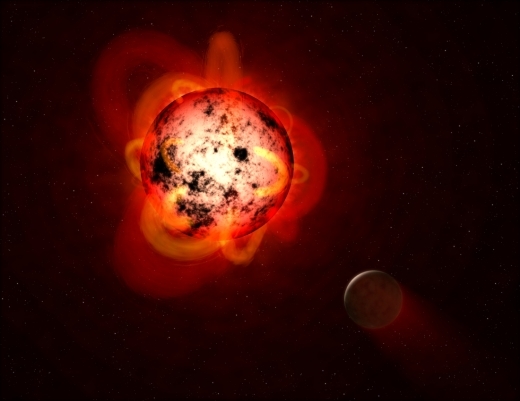
Image: Artist’s illustration of a red dwarf star orbited by a hypothetical exoplanet. Red dwarfs tend to be magnetically active, displaying gigantic arcing prominences and a wealth of dark sunspots. Red dwarfs also erupt with intense flares that could strip a nearby planet’s atmosphere over time, or make the surface inhospitable to life as we know it. Credit: NASA, ESA, and G. Bacon (STScI).
The software behind this project is significant because it can measure flare events that are much less energetic than previously detected from red dwarfs, reminding us that while major flares get our attention, persistent lower-strength flare activity could have the more dangerous cumulative effect on a closely orbiting planet. A significant amount of a flare’s total energy is released in the ultraviolet wavelengths GALEX observed, while the stars themselves are relatively dim at these wavelengths, offering contrast that made these results possible. The team was able to trace stellar variations lasting as little as a few seconds in the data.
“We have found dwarf star flares in the whole range that we expected GALEX to be sensitive to, from itty bitty baby flares that last a few seconds, to monster flares that make a star hundreds of times brighter for a few minutes,” said Million.
Many of the flares detected in the GALEX observations are similar to those that occur on our own Sun. But bear in mind that any planet in the habitable zone of a cool, dim red dwarf is going to be much closer to its host, making it subject to more of the flare’s energy than the Earth. Flares of large enough energy could play a role in stripping a planet of its atmosphere, while strong ultraviolet light from persistent flaring could damage living organisms.
The work was presented at the 230th meeting of the American Astronomical Society in Austin in early June. But the study is far from over. Clara Brasseur and team member Rachel Osten are now looking at stars that were observed both by GALEX and the Kepler mission, trying to track down similar flare activity. Hundreds of thousands of flares may be hidden in the data.
“These results show the value of a survey mission like GALEX, which was instigated to study the evolution of galaxies across cosmic time and is now having an impact on the study of nearby habitable planets,” said Don Neill, research scientist at Caltech in Pasadena, who was part of the GALEX collaboration. “We did not anticipate that GALEX would be used for exoplanets when the mission was designed.”
So we keep factors like these in mind as we assess the possible habitability of planets around stars like Proxima Centauri, LHS 1140 and TRAPPIST-1. While we’re learning that Earth-sized planets may be plentiful around red dwarfs, and that many may occur in the zone where liquid water could occur on the surface, the question of habitability is far from resolved.






June 7, 2017
The Golden Apples of the Sun
Alex Tolley mentioned Ray Bradbury’s story “The Golden Apples of the Sun” in connection with my first article on the Parker Solar Probe, and it’s a short tale worth remembering in connection with a mission flying so remarkably close to our star. First published in 1953 in a Doubleday collection of the same name, the tale is a short, mythic take on dangerous questing, with its main character, the unnamed captain, a figure something like Melville’s Captain Ahab. His goal is to fly to the Sun’s surface and retrieve some of its fire:
The captain stared from the huge dark-lensed port, and there indeed was the sun, and to go to that sun and touch it and steal part of it forever away was his quiet and single idea. In this ship were combined the coolly delicate and the coldly practical. Through corridors of ice and milk-frost, ammoniated winter and storming snowflakes blew. Any spark from that vast hearth burning out there beyond the callous hull of this ship, any small fire-breath that might seep through would find winter, slumbering here like all the coldest hours of February.
The ship and crew, fighting malfunctioning equipment, fall in their cryogenic ship “like a snowflake into the lap of June, warm July, and the sweltering dog-mad days of August.” It’s Bradbury in full poetic mode, not one of his best tales but one that does capture a bit of the natural human awe at stellar immensity. As for the Parker Solar Probe and the European Space Agency’s Solar Orbiter mission, neither will ‘touch the Sun,’ though the former will close to about 6.2 million kilometers, with the Solar Orbiter at 42 million kilometers.
Image: The dustjacket of the first edition of Bradbury’s collection The Golden Apples of the Sun. The title comes from the lush Yeats lyric The Song of Wandering Aengus. In an interview late in his life, Bradbury recalled: “Maggie [his wife] introduced me to romantic poetry when we were dating, and I loved it. I loved that line in the poem, and it was a metaphor for my story, about taking a cup full of fire from the sun.”
These missions are framed so as to study the near-Sun environment from different perspectives. Both are scheduled for launch in 2018, the Solar Orbiter in October and the Parker Solar Probe in July. What I’m seeing here are two complementary ventures, both examining the interaction between the Sun’s atmospheric gases and its magnetic field. Comparing the datasets should give us our best understanding yet of the inner heliosphere.
The key issues for the Solar Orbiter are listed on this European Space Agency page:
What drives the solar wind and where does the coronal magnetic field originate from?
How do solar transients drive heliospheric variability?
How do solar eruptions produce energetic particle radiation that fills the heliosphere?
How does the solar dynamo work and drive connections between the Sun and the heliosphere?
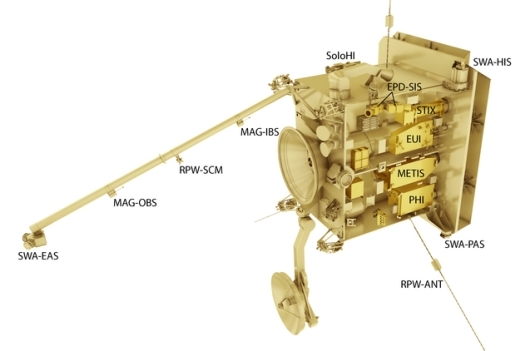
Image: Payload accommodation onboard Solar Orbiter. In this rendering, one side wall has been removed to expose the remote-sensing instruments mounted on the payload panel. The SPICE [Spectral Imaging of the Coronal Environment} instrument (not visible) is mounted to the top panel from below. Credit: ESA.
What Solar Orbiter brings to the mix is an orbit that will allow us to get close-up views of the Sun’s polar regions, with images from latitudes higher than 25 degrees. We should be able to see solar storms building up over an extended period from the same vantage point, because when traveling at the highest velocity along its orbit, Solar Orbiter will come close to matching the speed of the Sun’s rotation on its axis. We will be able to track solar storms for days.
Remember that many of the Sun’s jets originate in the areas around the poles, meaning we need more data about the magnetic field and plasma flows there to delve more fully into the process. These are not regions that are visible to us from Earth.
Understanding the solar wind also helps us consider the feasibility of future propulsion concepts using magnetic sail technologies to ride the solar wind. Meanwhile, the thermal issues a photon-driven sundiver mission will encounter will take center stage as we weigh the performance of the instrument packages on both these spacecraft. A sundiver would pass as close as possible to the Sun before unfurling a solar sail for maximum acceleration. We gain information from the upcoming solar missions that benefits both types of sail technology.
Solar Orbiter will carry a suite of 10 instruments to observe solar activity, 8 of them provided by ESA member states, while the other two are being developed by a European-led consortium and NASA respectively. A three and a half year approach to the operational orbit will include close flybys of Earth and Venus to insert the craft into a highly elliptical orbit. The instruments will measure solar wind plasma, fields, wave and energetic particles close to the Sun, while we can also expect images of solar features at the highest resolution ever seen.
So we’re going to have in situ measurements of the Sun’s extended corona from the Parker Solar Probe along with high-resolution studies of the inner heliosphere and the Sun itself from Solar Orbiter. Which takes me back to Bradbury’s captain, who has now ‘touched’ the Sun and is contemplating what is next:
“Well,” said the captain, sitting, eyes shut, sighing. “Well, where do we go now, eh, where are we going?” He felt his men sitting or standing all about him, the terror dead in them, their breathing quiet. “When you’ve gone a long, long way down to the sun and touched it and lingered and jumped around and streaked away from it, where are you going then? When you go away from the heat and the noonday light and the laziness, where do you go?”
We know where a sundiver sail mission would go: Outward, fast and far…






June 6, 2017
Into the Solar Wind
No spacecraft has ever flown as close to the Sun as the Parker Solar Probe will. The spacecraft will penetrate the outer solar atmosphere — the corona — where its measurements should help us understand the origin and characteristics of the solar wind. To put this in perspective, consider that Mercury is at 0.39 AU. The Helios-B spacecraft, launched in 1976, closed to within 43 million kilometers of the Sun (0.29 AU), the current record for a close pass. The Parker Solar Probe will fly seven times closer, moving within ten solar radii.
We need to learn a lot more about this region as we consider various mission concepts for the future. The Parker Solar Probe uses an 11.43 cm carbon-composite shield designed to keep its instrument package at room temperature, or close to it, despite outside temperatures well over 1350° Celsius. The sundiver concept we talked about yesterday — sometimes called a ‘fry-by’ — has the advantage of maximizing the effect of solar photons by unfurling a sail in close proximity to the Sun. To fly such a mission, we need to understand this environment.
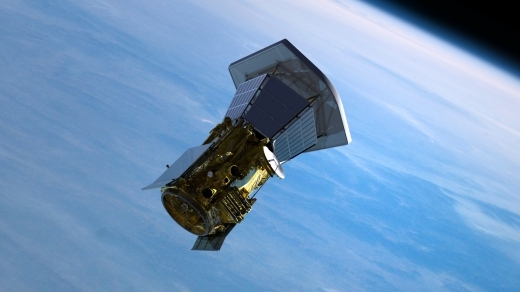
Image: The Parker Solar Probe spacecraft leaving Earth, after separating from its launch vehicle and booster rocket, bound for the inner solar system and an unprecedented study of the Sun. Credit: JHU/APL.
And let’s compare the Parker Solar Probe with the two Helios spacecraft in one other regard. Helios-B set the current speed record for spacecraft at 70.22 kilometers per second. The Parker Solar Probe should reach 194 km/sec. The goal of a future sundiver mission would be to turn solar photon pressure into maximum departure velocity out to deep space. Just how fast an outward-bound sail could fly will depend upon how close it can approach the Sun and what kind of materials it is made of, issues about which we have much to learn.
Conditions this close to the Sun are obviously going to be treacherous, and highly variable. The solar wind of electrons, protons and ionized helium nuclei flowing from the Sun can reach velocities as high as 800 kilometers per second. Unfortunately, the plasma flow is also highly variable, fluctuating over periods short and long. While we speak of ‘solar sailing’ by way of photon pressure on a sail, a truer analog to sailing is the use of a magnetic sail riding the solar wind. In the latter case, we have a highly variable ‘wind’ like mariners face on Earth, with all the attendant issues raised by its fluctuations. The study of both types of sailing should be enhanced by the data we retrieve from the Parker Solar Probe.
In Solar Sails: A Novel Approach to Interplanetary Travel (Springer, 2014), authors Giovanni Vulpetti, Les Johnson and Greg Matloff consider the positive electric charge that can emerge on a sail as ultraviolet solar photons knock electrons free from sail atoms. The problem here is that interactions with high-energy electrons can degrade sail reflectivity. A possible strategy is to deploy an electrically charged grid in front of the sail or use layers of protective plastic that evaporate rather than becoming ionized by solar ultraviolet light.
But every time we add mass to the sail, we reduce the spacecraft’s velocity outbound, meaning we’re probably going to be better served by designing solar sails that are more resistant to UV. It’s clear that we have a lot of work ahead on the interactions between spacecraft and the near-Sun environment, the subject of the Parker Solar Probe’s investigations. Of course, the upcoming probe is also set to investigate the interactions between the solar wind and the Earth’s magnetic field that produce so-called ‘space weather.’ Learning how to predict this kind of weather can protect space assets much closer to home.
A Mechanism for Solar Eruptions
We also need to consider solar activity, for flying any kind of mission within 10 solar radii is going to be dangerous if we have to contend with solar flares or coronal mass ejections. We can do our best to predict the occurrence of such dangers to the spacecraft, but CMEs appear to be random enough that the unexpected appearance of one could quickly end a mission.
On that score, a new paper in Nature looks at a single mechanism that can explain solar eruptions from small jets to coronal mass ejections, working with 3D computer simulations to reveal the underlying process at work. Peter Wyper (Durham University, UK), lead author of the study, notes that filaments — long, dark structures above the surface of the Sun consisting of dense and colder solar material — are associated with the onset of CMEs. We’re now learning that solar jets have filament-like structures as well before their eruption.
“In CMEs, filaments are large, and when they become unstable, they erupt,” said Wyper. “Recent observations have shown the same thing may be happening in smaller events such as coronal jets. Our theoretical model shows the jet can essentially be described as a mini-CME.”
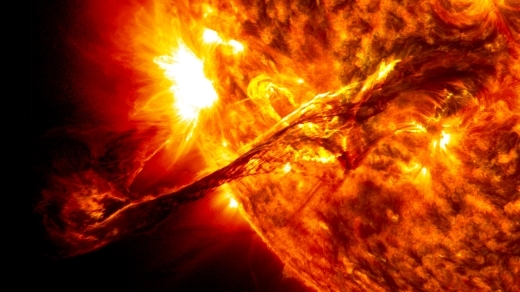
Image: A long filament erupted on the sun on Aug. 31, 2012, shown here in imagery captured by NASA’s Solar Dynamics Observatory. Credit: NASA’s Goddard Space Flight Center/SDO.
The researchers at Durham University and at NASA have produced a ‘breakout model’ showing how stressed filaments break through magnetic restraints in both solar jets and CMEs. In this model, the process at work is magnetic reconnection, in which magnetic field lines come together and realign into a new configuration. The event is powerful enough that the energy stored in the filament breaks out from the surface and is ejected into space.
The Parker Solar Probe gives us another way to obtain high-resolution observations of the magnetic field and plasma flows in the solar atmosphere. We can expect similar help from the European Space Agency’s Solar Orbiter mission, scheduled for a launch in the fall of 2018. Unlike the Parker Solar Probe, the Solar Orbiter will go into an inclined orbit that allows better imaging of the areas around the Sun’s poles. Both missions obviously deepen our resources for sundiver mission planning as we contemplate fast departures into the outer system.
Tomorrow I’ll take a look at ESA’s Solar Orbiter in the context of our continuing efforts to understand the nearest star. The paper on solar eruptions is Wyper et al., “A universal model for solar eruptions,” Nature 544 (27 April 2017), 452-455 (abstract).






June 5, 2017
Parker Solar Probe: Implications for Sundiver
We’re going to be keeping a close eye on what is now called the Parker Solar Probe as work continues toward a July 2018 launch. This is a mission with serious interstellar implications because it takes us into the realm of so-called ‘sundiver’ maneuvers in which a solar sail could be brought as close as possible to the Sun (perhaps behind a protective occulter) and then unfurled to get maximum effect. Velocities well beyond Voyager’s can grow from this.
Throw in the prospect of beamed propulsion and such sails could receive an additional boost. To be sure, the Parker Solar Probe is not a solar sail but an unmanned, instrumented probe designed to explore a region as close as 10 solar radii from the Sun’s surface, where temperatures can be expected to reach about 1375° Celsius. But the sundiver implications are there, and we’ll gain priceless data about operations in this extreme environment.
Why a sundiver? Voyager 1 is exiting the neighborhood of the Solar System at 17.1 kilometers per second. And while New Horizons left Earth breaking all speed records for spacecraft launched into interplanetary space, it’s worth remembering that its velocity during the Pluto/Charon encounter had fallen to about 14 kilometers per second, a consequence of the long climb out of the gravity well. So finding ways to get spacecraft to two or three times this velocity is an obvious objective as we explore ways of moving faster still.
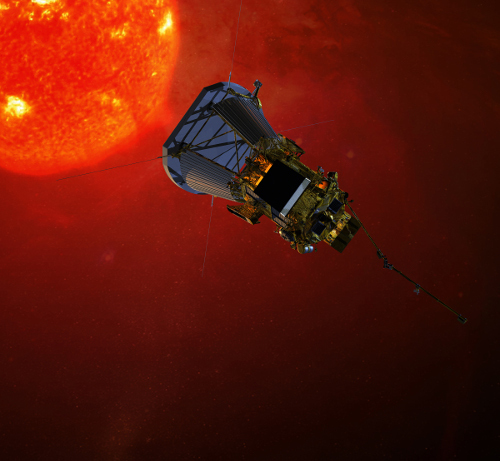
Image: Artist’s impression of NASA’s Solar Probe Plus spacecraft on approach to the sun. Set to launch in 2018, Solar Probe Plus will use Venus’ gravity during seven flybys over nearly seven years to gradually bring its orbit closer to the sun. The spacecraft will fly through the Sun’s atmosphere as close as 6.2 million kilometers to our star’s surface, well within the orbit of Mercury and more than seven times closer than any spacecraft has come before. Credit: NASA/Johns Hopkins University Applied Physics Laboratory.
The first use of the word ‘sundiver’ in a scientific paper that I am aware of is Greg and Jim Benford’s “Near-Term Beamed Sail Propulsion Missions: Cosmos-1 and Sun-Diver” (Beamed Energy Propulsion, AIP Conf. Proc. 664, pg. 358, A. Pakhomov, ed., 2003), though the word’s history goes back a bit further to David Brin’s 1980 novel Sundiver, which turned out to be the first book in his Uplift Trilogy. Greg Benford worked with Brin on some of the novel’s concepts, discussions that he recalled in a column in Fantasy & Science Fiction:
I called this craft the Sundiver. The term is old—I gave it to David Brin when he first came to see me, back when he was struggling with his first novel. (As he now recounts, I asked him how his craft that literally plunges into the Sun could survive. He answered that he would throw in some jargon, techtalk, whatever. I disdainfully replied, “Oh—magic.” So David went home and found a physically possible way to do it, confounding me.)
I read Sundiver not long after it came out and don’t recall anything like a close solar pass mission — instead (as Benford says above), Brin was looking for a way to actually get a craft into the Sun by way of exploring the novel’s unusual lifeforms, creatures that lived off magnetic fields in the chromosphere. But the Benford paper mentioned above (available here) discusses sail concepts using a close solar pass as well as desorption of heated embedded molecules from the hot side of the sail that can deliver a second propulsive ‘burn.’
Let’s pause on desorption, which turned out to be interesting because in their laboratory work at JPL pushing an ultra-light carbon sail with a microwave beam, the Benfords found that the beam alone could not account for the acceleration they observed. Subsequent investigation showed that embedded molecules — CO2, hydrocarbons and hydrogen that had been incorporated in the sail material lattice when it was made — could be ejected under high enough temperatures. The original sail material was left unharmed by this propulsive effect.
Incorporating that phenomenon into a sundiver mission, we get this: The sail approaches the Sun turned edge-on to minimize solar flux that would push against it. The spacecraft then turns at perihelion to get the full effect of both photons and related sail desorption, gaining velocity even as (because of the loss of some of the molecules in its fibers) it loses a bit of mass. When desorption is complete, the sail operates like any other solar sail, though one now moving fast enough to explore the outer Solar System in far less time than it took Voyager.
On the way to a sundiver, what the Parker Solar Probe gives us, among other things, is the ability to investigate the high energy particle environment that any future sundiver mission would have to cope with. An 11.43 cm carbon-composite shield will be used to protect the craft. We’ll learn much about the solar wind, findings that will also prove useful as we contemplate future magsail possibilities, in which a spacecraft might use the highly variable plasma flow to reach high velocities. More about that possibility tomorrow, when we’ll take a closer look at the conditions the Parker Solar Probe will face and ponder the insights it is certain to provide.






Paul Gilster's Blog
- Paul Gilster's profile
- 7 followers




